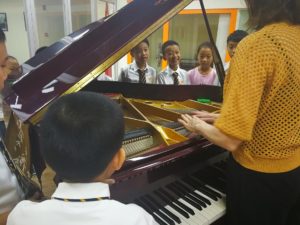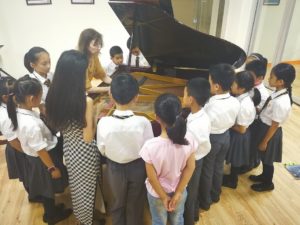An impromptu opportunity to showcase how a piano makes sound and in comparison to how our voice box makes sound arose when we needed to re-arrange our rehearsal space. This meant our three youngest choirs in the Zhuhai Classical Children’s Choir program were able to practice with the Kawai grand piano as opposed to the usual digital upright.
Most of our youngsters had never seen the workings of a piano much less what is under the lid of a grand piano. . .
Since the strings of a grand piano run parallel to the floor, it’s easier to imagine how our vocal folds are situated in our neck. Watching the piano hammer strike and observing the release of the damper, our youngest choirs (Byrd and Purcell, ages 8-11) witnessed the vibration that begins and heard the sound that happens. We compared this to the air pressure that causes the vocal folds to abduct and adduct in order to initiate vibration and create sound. We also noted the striking of the hammer as being similar to the collision our vocal folds make when we speak and sing. We talked about the speed of the hammer hitting the strings and compared it to the gentle or glottal onsets of the vocal folds. This also allowed us to contrast the difference between legato and staccato articulation.
They could also see the similarities between their small vocal folds and the piano strings in the treble register. Of course, their folds are not near as long or big in diameter, but they could see the difference in the size of strings at the upper end and the lower end. This helped them understand proportionally a little more about the size of a child’s vocal folds and adult female and male vocal folds.
We compared the sound board to our natural resonators, the throat, the mouth and our nose. We talked about the speed of the hammer hitting the strings and compared it to the gentle or glottal onsets of the vocal folds. This also allowed us to reinforce the difference between legato and staccato. Even though we have used kinesthetic movements to experience these elements of singing, we have now made another connection with the visual aid of the grand piano.
In our Purcell Choir the children are 9 – 11 years old. For most of them, it is their first year to sing in our choir. When asked how many study the piano privately, 14 hands shot up. That’s 60% of our class! Pretty impressive China!
I believe that by the end of our rehearsal, we made a lasting impression by pointing out the workings of the piano in contrast and comparison to our own voice box.
Just look at that shining face in middle of the frame! This is the afternoon Byrd class. . .


For more classroom ideas and information on the science behind the voice, please visit: DevelopingVoices.blog


Leave a Reply
You must be logged in to post a comment.